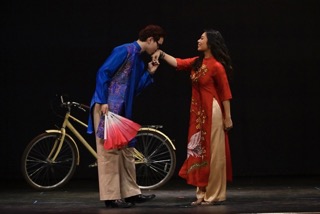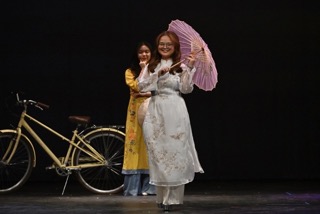The fashion show stands out as a spectacular display of global cultures, allowing students from numerous countries to prepare for months to represent their own or another’s heritage. This unique aspect of Cabaret not only promotes an understanding and appreciation of diversity among Lawrentians and the greater community but also encourages active participation. Any student, regardless of their background, is invited to join in and share their culture through fashion, fostering a dynamic integration among the various cultures represented on campus.
Here you can find the description of 2024 Cabaret fashion show.
Japanese Culture Exchange Club (JCEC)
The kimono is a traditional form of Japanese clothing. It was created around 1,050 years ago, and now people wear it for specific, special occasions.
Presented here are kimono and yukata, with the main difference being the material. Yukata is made to be cooler than kimono, but there is not a large difference between the styles of the two garments. In summer, many people wear yukata to go to summer festivals and enjoy the fireworks.

Pokémon has been delighting children and adults alike with anime, video games, and card games for more than 25 years. The journey of a Pokémon trainer: choosing a starter, raising and training a part of Pokémon, battling through Pokémon gyms and the elite four to become the Pokémon champion, all while catching Pokémon for the Pokédex, is one many have undertaken.
Here we have Dawn, one of the main trainers from Pokémon’s fourth generation, with her partner Pokémon Piplup. She’s encountered a wild Pikachu and Psyduck! It’s time to catch one!

Here we have Ai, Ruby, and Kana from Oshi no Ko. Oshi no Ko is a new, very popular Japanese anime. Ai Hoshino is a very popular idol. When she has twins, Ai’s son is the reincarnation of her obstetrician, who dies in a murder. Ai’s daughter, Ruby, is the reincarnation of another of the doctor’s former patients.

When Ai is murdered by the same man who killed her doctor, the twins believe someone in the entertainment industry is behind it, so they begin their careers in entertainment at their high school. With their classmate Kana, a former child prodigy, the three debut as an idol group.
Garam Masala group
South Asian clothes are traditionally made out of cotton, silk, chiffon, etc. They range from very simple for regular wear, to heavily embellished, embroidered, or patterned for weddings, social gatherings, and religious festivals.
Traditionally, women in India and Bangladesh wear Sarees, Ghaghra Choli, Salwaar kameez, or a Kurta with a dupatta, based on what region they are from or personal preference. Men wear a Kurta or a Sherwani, with a Dhoti, Pyjama, or a Salwaar at the bottom. In Bangla, these are referred to as Panjabis. They can also be paired with a shawl or a jacket.
Chinese Student Association (CSA)
Originating from ancient China, Hanfu is not just clothing; it’s a story, a tradition that carries the depth of Chinese history and culture.
As we walk through history, you’ll see the elegance and grace of Hanfu styles that have evolved over centuries. From the flowing robes of the Han Dynasty to the intricate designs of the Tang and Song dynasties, each piece tells a tale of its era, embodying the harmony between humanity and nature, an essential philosophy in Chinese culture.
Hanfu has made a remarkable comeback today, symbolizing a bridge between the past and the present. It represents a growing interest in traditional culture among the younger generation, who wear it to celebrate festivals and special occasions, reviving and keeping the heritage alive.
Pakistani group
Pakistan is a country filled with vibrant colors, amazing food and beautiful poetry. Traditional Pakistani clothing reflects a rich history and timeless elegance. Shalwar kameez showcases intricate embroidery and vibrant colors. Such colors, delicate embroidery, and graceful draping techniques highlight the skilled craftsmanship passed down through generations.

Pakistani attire is known for its beauty along with modesty, bringing out a very pure side of south Asian Fashion. This clothing blends traditions influenced by the Mughal Empire. Islam’s spread introduced Persian art and culture, shaping designs. Today, Pakistani garments remain a symbol of heritage and timeless elegance, adapting to modern influences while honoring historical roots of modesty and purity.
Morocco by Debbie
Moving on to the oldest second kingdom in the world: Morocco.
Located in northern Africa, the Kingdom of Morocco is a country that hides one of the oldest and richest cultures in the world which influence is seen in Moroccan clothing .

The takshita is a sumptuous and elegant traditional Moroccan dress worn during festive events such as weddings and religious celebrations usually made from rich and luxurious fabrics and adorned with hand made embroidery and beads.
The takchita inspires prestige and is the flagship of Moroccan chic and elegance.
Korean Culture Club (KCC)
Hanbok is the most representative Korean clothing that has been worn since 18 BC, literally meaning Korean Clothes. A full set of hanbok for men consists of a vest, jeogori (top jacket), and a pair of pants, and women’s includes a jeogori, underskirt, skirt, and a pair of pantaloons. Nowadays, hanbok is a formal wear only worn on special occasions or anniversaries.
Vietnamese Cultural Organization (VCO)
“Áo dài” is a revered symbol of Vietnamese culture, worn by both men and women on special occasions to showcase elegance and tradition. For women, it consists of a form-fitting silk tunic adorned with intricate embroidery or embellishments, paired with long, flowing pants. The tunic boasts a high neckline and long sleeves, accentuating the feminine silhouette with grace and modesty. Meanwhile, the men’s version features a loose-fitting silk tunic with a mandarin collar and five-button detail, complemented by straight-cut trousers. Both ensembles are often accompanied by a “Nón lá” (conical hat) and minimal yet tasteful accessories, serving as a testament to Vietnamese heritage and cultural pride. “Áo dài” encapsulates not only style but also the essence of tradition, making it an enduring symbol of identity and celebration in Vietnamese society.
Melee
Hanfu (simplified Chinese: 汉服; traditional Chinese: 漢服; pinyin: Hànfú) are the traditional styles of clothing worn by the Han Chinese. Traditionally, hanfu consists of a paofu robe, or a ru jacket worn as the upper garment with a qun skirt commonly worn as the lower garment.

Mamianqun (simplified Chinese: 马面裙; traditional Chinese: 馬面裙; pinyin: mǎmiànqún; lit. ‘horse face skirt’), is a type of traditional Chinese skirt. he Mamianqun is a type of qun (Chinese: 裙; pinyin: qún; lit. ‘skirt’) a traditional Chinese skirt worn by the Han Chinese women as a lower garment item in Hanfuand is one of the main representative styles of ancient Chinese-style skirts. It originated in the Song and Liao dynasties and became popular due to its functionality and its aesthetics style. It continued to be worn in the Yuan, Ming, and Qing dynasties where it was a typical style of skirt for women and was favored for its unique aesthetic style and functionality.
















